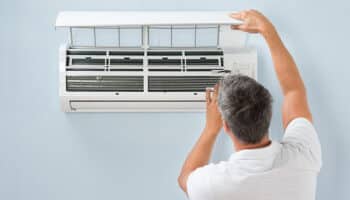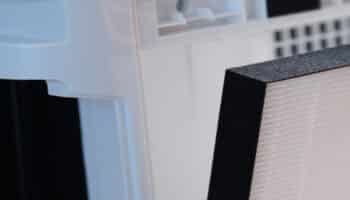We've independently reviewed this article to make sure it's as accurate as we can make it.
To find out more about our article creation and review process, check out our editorial guidelines.
That little number on our thermostat can stir up a lot of decisions about how warm or cool the room should be.
One question that often came up for me is, “How cold CAN we set the air conditioner temperature”? To find out, I’ve done a lot of research and this article is the result.
So How Cold Should You Set A Thermostat?
The minimum temperature you should set your thermostat to is around 65 degrees. Any lower than this will put a constant strain on your air conditioner. An AC can typically drop temperature by a maximum of around 20 degrees (11C). If you set your thermostat lower than 68 degrees, your air conditioner will strain itself to cool the room so much – causing extra wear and tear.
Note – air conditioners are sized for cooling with an inside temperature of 75F with 50-60% humidity. While they can go lower, the air conditioner’s coils get to around 40-50 degrees. So as you go lower, you run into the law of diminishing returns.
This is a hot topic lately – especially with environmental impact of overcooling (not to mention the cost of straining your air conditioner). The government of Spain has actually mandated that businesses can’t set their air conditioners below 68F (27C).
Thermostat Temperature Ranges
We’ll dive into more detail about the how’s and why’s below, but first I want to share these tables I’ve put together. They show approximately the recommended and lowest temperatures for a range of outside temperatures, based on recommendations by Energy Star & The Department of Energy.
| Temperature (Fahrenheit; oF) | ||||
|---|---|---|---|---|
| Outside | In Room | Sleeping | Out | Coldest |
| 80 | 78 | 82 | 85 | 60 |
| 85 | 78 | 82 | 85 | 65 |
| 90 | 78 | 82 | 85 | 70 |
| 95 | 78 | 82 | 85 | 75 |
| 100 | 80 | 84 | 87 | 80 |
| 105 | 85 | 89 | 92 | 85 |
For Fahrenheit (above), and for Celsius (below).
| Temperature (Celsius; oC) | ||||
|---|---|---|---|---|
| Outside | In Room | Sleeping | Out | Coldest |
| 26.7 | 25.6 | 27.8 | 29.4 | 15.6 |
| 29.4 | 25.6 | 27.8 | 29.4 | 18.3 |
| 32.2 | 25.6 | 27.8 | 29.4 | 21.1 |
| 35.0 | 25.6 | 27.8 | 29.4 | 23.9 |
| 37.8 | 26.7 | 28.9 | 30.6 | 26.7 |
| 40.6 | 29.4 | 31.7 | 33.3 | 29.4 |
Based on recommendations by Energy Star & The Department of Energy.
How Cold Can You Set A Thermostat?
Let’s start with the basic settings. Generally, the Department of Energy recommends us to set our thermostats to 78F (26C) to be comfortable. Of course, you can vary this as you feel is right.
The ACCA Manual J used by HVAC system designers calculates air conditioner loads to reach 75F.
If we’re wondering how low it can go, then the general answer is that air conditioners are built to achieve a total drop of around 20F (11C) from the outside temperature.
In other words, they’re not made to continually go lower and lower until the room is freezing! Instead, they can achieve a certain drop from a starting temperature. If the outside temperature is 90F, they’ll get us to around 70F at the lowest.
Of course, always putting it as low as it can go has it’s drawbacks. For one – money. Every degree you set your thermostat higher, you save around 3% on your utility bill. This may not seem like much, but it sure does add up.
EnergyStar – a program by the US Environmental Protection Energy & Department of Energy to promote energy efficiency – has recommendations on how to maximize your efficiency.
If you’re sleeping, they recommend you increase the thermostat by 4F (12% saving). And if you’re away from home, they recommend a 7F increase (21% saving!).
“But why wouldn’t I just turn off the AC?”
Unless you’re going to be gone for days, air conditioners work best when they remain on for long periods of time. What costs the most energy is the initial sprint to cool your space down from a hot temperature. Once it’s cool, it takes less energy to maintain. That’s why it’s best to leave the aircon on, but also raise the temperature a few degrees to lower the demand on it.
Need More Cooling?
It may be the easiest option, but hammering ‘colder’ on your AC controls may not be the best idea! You’ll put a lot of strain on the air conditioner and maximize your energy bills.
Instead, we can increase the efficiency of your air conditioner – so it does a better job using the same power.
Ways to Stay Cooler Without Turning Up The Air Conditioner:
- Block Out The Sun. When it comes to windows, the rule is: if it’s in the sun, close the window AND the curtain/blind. If it’s in the shade, you can leave the curtains open. Worst case? Put up a reflective material to bounce back the heat.
- Go all-in on insulation. With an air conditioning system, we want to separate our home from the outside as much as possible. Making sure you’re well-insulated – especially making sure old windows and doors aren’t letting the cool air out. Seal and caulk as necessary.
- Close off your hottest rooms. If there’s a room in your home that’s always turning into a furnace, try to block it off from the rest of your home. Keep the door closed and focus on cooling the areas you spend the most time in.
- Minimize heat production. If you need to do cooking, laundry, or use any heat-based appliances, try to keep these off until the evening (or first thing in the morning). Similarly, be mindful about the food you prepare and how much heat your AC will need to deal with as a result.
- Use Minimal Electronics. Everything that uses power creates heat. Unplugging everything you don’t use will make a difference. This especially applies to lights!
There’s a ton of these tactics you can use to stay cool without turning up the AC power. In fact, we’ve put together the largest list of tips on the internet!
Check out our massive 73-tip guide to staying cool without air conditioning. There’s guaranteed to be at least a few tips you can use right now.
Don’t have a Central AC?
Many homes and apartment stay cool using only window or portable air conditioners. These are totally fine, just be aware that the thermostat is located within the air conditioner. This can give a bit of a false reading since the unit will likely be in the corner/window of the room.
The best way to make sure they’re working correctly is to get your own thermometer. Even just a simple $5 one from WalMart. That way you can tell what the air temperature actually is, and adjust the AC accordingly.
Want to pay money to save money?
Consider picking up a smart thermostat. Smart thermostats can save you money in the long run by always keeping things at the right temperature. Forgetting to increase the temperature when you’re asleep or leaving home can quickly add up in bills. 8 hours of extra cooling power adds up to a lot in energy costs! Plus, Smart thermometers can show you other stats, too. Like your actual energy usage throughout the day, or how much you’re spending/saving.
They’re also far more comfortable and convenient. Remove any stress of always being concerned about what temperature you’ve set by having it automatically programmed and adjustable. Taking the time to program it correctly means your home is already the perfect temperature when you walk in the door – you don’t need to fire the system to maximum and quickly grasp for a glass of ice water while you wait.
Make Sure Your Thermostat is Happy
With any type of technology, if we have the wrong inputs we’ll not get the right outputs. It’s important to make sure your thermostat is positioned correctly.
All this means is that it’s getting the actual air temperature of your space. Make sure it’s not in direct sunlight or near drafty areas like doors or windows. Make sure not to block it with furniture, too. That said, do keep it somewhere easy to reach! Make it convenient to check the temperature’s correct.
Consider Single-Room Cooling
If you do have a central air conditioner but are worried about over-cooling or high energy bills, consider picking up a mini-split unit, or a window / portable air conditioner.
While less powerful, these use less energy and focus the cooling in one part of your home. Ideal if you tend to spend most of your day in one room. Portable units can also be moved from the living space to the bedroom for a cool night’s sleep.
Worried about a noisy unit? We’ve got you covered.
I’ve created detailed breakdowns of the quietest portable air conditioners AND the quietest window ac units. Being cool shouldn’t mean we need ear plugs!
Conclusion
Thermostats have to be one of the most debated appliances in our home. What settings, when, and how long for – I don’t know any household where everyone agrees.
I hope this quick article has at least helped you understand a little more about how to get the most out of your air conditioning system. And how to help make things cooler without blowing up your energy bills.
If this content has helped you, please consider supporting us by checking out some more articles or signing up to get the amazing deals we share in our private mailing list (in the side bar).
Have a great day!
-Craig







